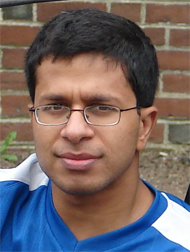
|
|
|
TutorialSTACS 2014 will also include a 3-hour tutorial on Arithmetic Circuit Complexity by Neeraj Kayal, Microsoft Research India (beginning at 10am on Wednesday, March 5). A detailed schedule can be found on the miniworkshop page. Post-conference update: the tutorial's slides are online.
Abstract: Arithmetic Circuits compute polynomial functions over their inputs via a sequence of arithmetic operations (additions, subtractions, multiplications, divisions, etc.). This tutorial will give an overview of arithmetic circuit complexity, focusing on the problem of proving lower bounds for arithmetic circuits. In the first part, we begin with a few nontrivial upper bounds – matrix multiplication and the computation of symmetric polynomials. We then motivate some open problems we deal with in arithmetic circuit complexity. We will look at the problem of polynomial identity testing - motivating it by its application to bipartite matching, the problem of learning arithmetic circuits or circuit reconstruction and the problem of proving lower bounds for arithmetic circuits (motivating it via the problem of computing the permanent and the Hamiltonian polynomials). We will also see depth reduction for circuits – the tradeoffs involved (with respect to size) in squashing a circuit into one with smaller depth. In the second part, we will see some classical lower bounds. In particular, we will see lower bounds for monotone arithmetic circuits and multilinear formulas. We then give a very quick overview of approaches being investigated (including geometric complexity theory and tau-conjecture) aiming to prove lower bounds. In the third part, we begin with a warm-up by proving lower bounds for homogeneous depth three circuits. We will then see recent lower bounds for homogeneous depth four circuits and its consequences. |


